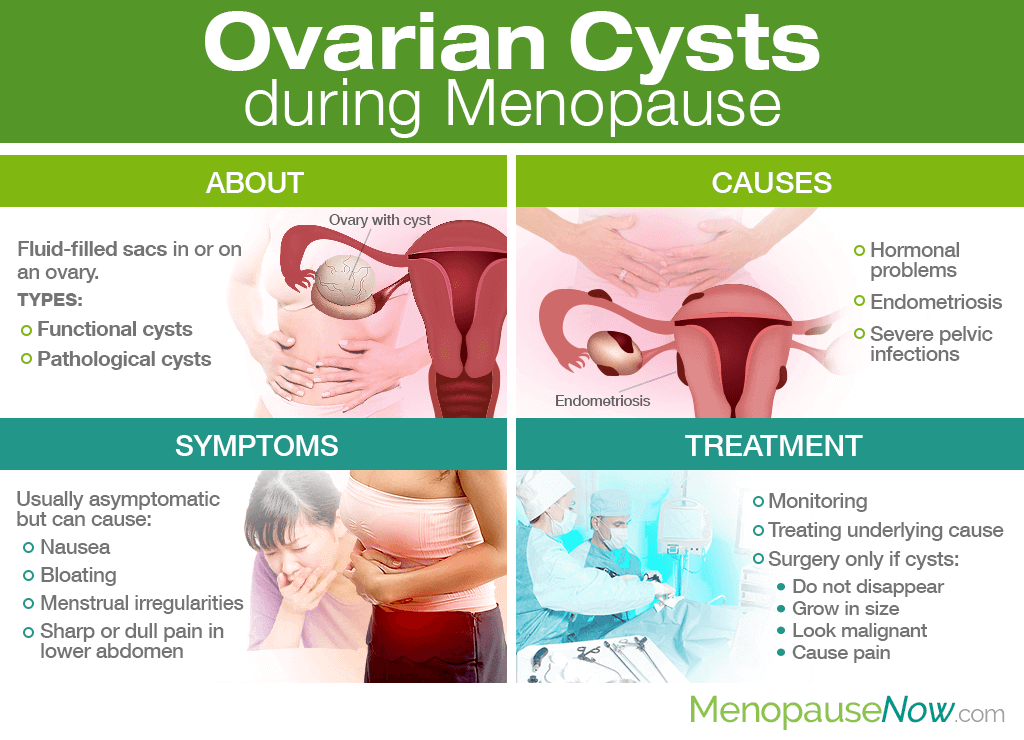Even in perimenopause and into postmenopause, ovarian cysts are more common than most women think, and if not addressed properly, they can lead to life-long complications.
Continue reading to learn more about ovarian cysts during menopause, including what they are, symptoms, causes, and how to find effective treatment for long-lasting relief.
What are Ovarian Cysts?

An ovarian cyst is a fluid-filled sac that develops in or on an ovary.
Most develop as a part of ovulation during the menstrual cycle, known as functional cysts. Others are caused by abnormal cell growth and are not related to the menstrual cycle, known as pathological cysts.
Functional cysts
These are the most common types of ovarian cysts. They form during the menstrual cycle and are benign:
Follicular cysts. This type of cyst develops when the follicle does not rupture or release its egg. Instead, the follicle continues to grow. Remember that the follicle is where the eggs mature on a monthly basis during ovulation.
Corpus luteum cysts. Once the follicle releases the egg, the remnants of the follicle are called the corpus luteum. Sometimes, fluid will accumulate inside of the corpus luteum, causing the structure to develop into a cyst.
Functional cysts should not form once a woman reaches menopause and no longer has a period since their formation is dependent upon the events of the menstrual cycle.
Pathological cysts
Pathological ovarian cysts can develop during postmenopause. These include:
Dermoid cysts. Also known as teratomas, these ovarian cysts form from embryonic cells and contain tissue, hair, skin, or teeth.
Cystadenomas. These ovarian cysts may be filled with watery or mucous-like material and form on the surface of an ovary.
Endometriomas. These develop due to endometriosis, which is when endometrial cells grow outside of the uterus. Some of the tissue forms a growth when it attaches to the ovary.
In general, cysts are usually benign (non-cancerous), but they may grow to be malignant (cancerous) and need surgery.
What are Symptoms of Ovarian Cysts?

In women of all ages, ovarian cysts usually do not show symptoms. Oftentimes, women will not know of their presence until a routine pelvic exam.
However, when they are symptomatic, the most common ones are:
- Nausea
- Menstrual irregularities
- Bloating
- Constipation
- Sharp or dull pain in the lower abdomen, usually on one side
- Feeling full after eating a small amount of food
If you experience sudden, severe pelvic pain; cold, clammy skin; rapid breathing; lightheadedness; or pain with a fever or vomiting, seek immediate medical attention as the cyst has most probably ruptured.
What Causes Ovarian Cysts during Menopause?

Ovarian cysts during menopause can be caused by the same factors as ovarian cysts before menopause, which include:
Hormonal problems. One of the most common endocrine system disorders that causes enlarged ovaries with cysts is polycystic ovary syndrome (PCOS). PCOS can continue into menopause.
Endometriosis. This painful disorder causes the type of benign ovarian cyst known as an endometrioma.
Severe pelvic infections. Pelvic infections can cause ovarian cysts during perimenopause since it is not uncommon for the infection to spread to the ovaries and fallopian tubes.
Are Ovarian Cysts Common?
Many women will have ovarian cysts sometime throughout their reproductive lives, from puberty until the onset of irregular periods (signaling the beginning of perimenopause).
As a matter of fact, the majority of cysts will disappear within a few months without presenting symptoms or needing treatment.
However, once a woman enters menopause, while the ovaries do have decreased levels of activity, they are still capable of producing and having cysts.
Nevertheless, ovarian cysts during and after menopause are less common.
Should I Be Concerned?
In general, menopausal women should not be too concerned over the presence of ovarian cysts.
However, postmenopausal women with ovarian cysts are at a high risk for ovarian cancer, making it all the more important for them to perform routine pelvic exams. While not all ovarian cysts are malignant in postmenopause, any cysts encountered will be monitored closely for changes in characteristics.
How Can I Treat Ovarian Cysts during Menopause?

Surgical or non-surgical intervention will be pursued depending upon symptoms and stage in reproductive life since the risk for ovarian cancer increases as women age.
Surgical Intervention
For menopausal woman still having their periods, ovarian cysts may require surgical removal in the following instances:
- Do not disappear after several menstrual cycles
- Get larger
- Look malignant on an ultrasound
- Cause pain
If cysts do not require immediate surgery, women often pursue “watchful waiting.” This means that they will not receive instant treatment but will have an ultrasound every few months to monitor the cysts' progress.
Non-Surgical Intervention
During “watchful waiting,” it would also be wise for menopausal women to treat the underlying cause at fault for their ovarian cysts.
If due to hormonal problems, such as PCOS or endometriosis, women should consider menopause symptoms treatments that focus on non-invasive measures to holistically encourage endocrine system health. These will not only address the cysts but other symptoms of hormonal imbalance that could surface at this time, such as hot flashes, night sweats, vaginal dryness, and more.
If due to other factors, women should work with their doctors to find the best solution for their overall reproductive health and well-being.
Sources
- Familydoctor.org. (2018). Ovarian Cyst. Retrieved May 21, 2019, from https://familydoctor.org/condition/ovarian-cyst/
- Mayo Clinic. (2017). Ovarian cysts: Symptoms & causes. retrieved May 21, 2019, from https://www.mayoclinic.org/diseases-conditions/ovarian-cysts/symptoms-causes/syc-20353405
- NHS. (2016). Causes: Ovarian cyst | Treatment: Ovarian cyst. Retrieved May 21, 2019, from https://www.nhs.uk/conditions/ovarian-cyst/causes/ | https://www.nhs.uk/conditions/ovarian-cyst/treatment/
- Office on Women's Health. (2019). Ovarian cysts. Retrieved May 21, 2019, from https://www.womenshealth.gov/a-z-topics/ovarian-cysts

